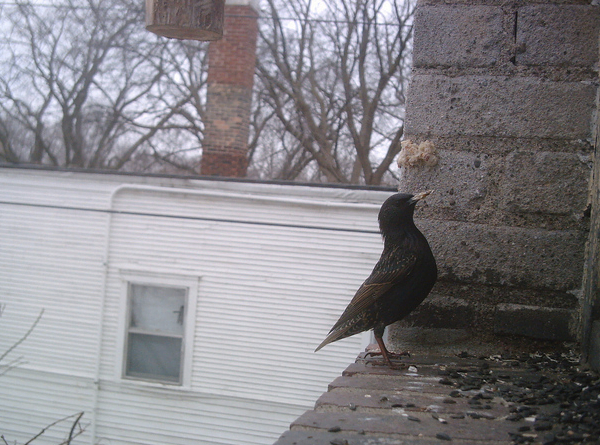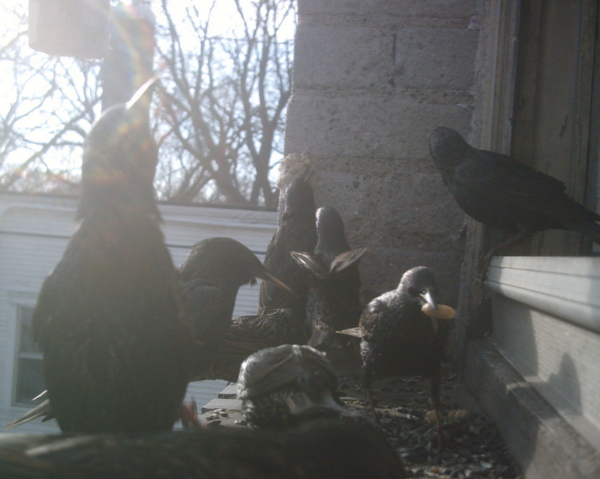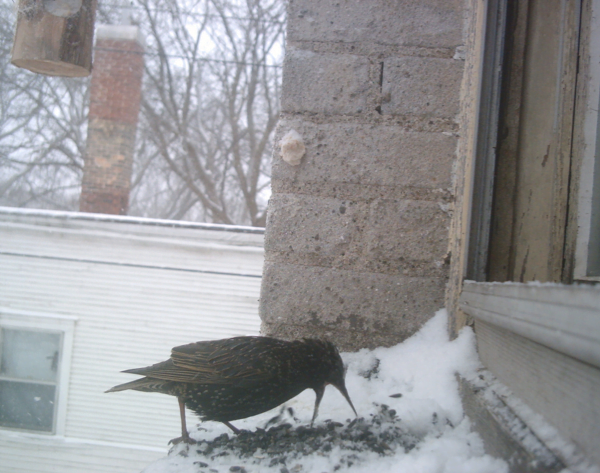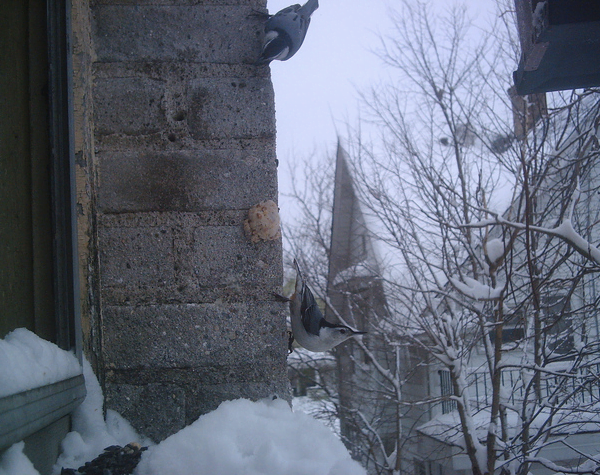Last weekend was the annual Great Backyard Bird Count, an effort to get folks all over North America to take note of the birds in their yards. This can be a big bump in bird feeding, might as well keep those feeders topped to pump up the number of species that you can record. I have a delicate tap dance at my feeders. I live in an apartment building in a very urban section of Minneapolis (I live in Uptown, which is where you go to get pierced, tattooed and have a fancy meal).
I’m not supposed to feed birds, but because we moved in and the previous owners of the building allowed it and we have a tendency to pay rent on time and act as mediator with noisy neighbors, management lets me get away with it. They periodically suggest that I use seed that is “less messy” but for the most part, the building manager turns a blind eye to the lack of grass beneath my window since we are in the back.
Because I live so close to downtown, my top three feeder guests are non-natives, particularly the bad boy in the above photo: the European Starling. I took this photo with my WingScapes Bird Cam. Alas, when you get starlings to a feeder, you don’t get just one starling.
You tend to get a butt load at a time. This ever vigilant flock had caught wind that I was putting out peanuts out of the shell on my window ledge and swooped in to gobble them up. The intended treat was for nuthatches and chickadees, but starlings will snarf these up faster than your average vacuum cleaner. When that happens, I return to my original choice of food to offer birds: black-oil sunflower seed.
Check out this photo of a starling on my ledge. Note the beak action going on there? Starlings will use that bill opening technique to move debris covering a food source or to open soil and expose worms and other insects. They are very good at opening their beaks. However, they have a soft insectivor type beak and cannot crack open hard shell seeds. By offering only seed in the shell like black-oil sunflower, striped sunflower, safflower and even white millet you can avoid starlings. It is physically impossible for starlings to open those seeds. If you see a starling at a feeder with those seeds, they are using that bill opening technique to sift hard shelled seeds out of their way and search for seed hearts. They usually give up and leave the feeder alone.
This is a photo I digiscoped. Here the starling is all over this Droll Yankee feeder chock full of peanuts out of the shell. They will also chow down on sunflower hearts and cracked corn–no cracking, just swallowing. All of those are seeds that my building manager would like me to offer because they will not leave a mess under my feeders. But if it’s a choice between avoiding starlings or lack of shells under my feeder, I’ll take avoiding starlings every time.
Most of my other birds totally dig the black oil sunflower seeds like these two White-breasted Nuthatches as do chickadees, titmice, finches, cardinals and jays are all capable of cracking open a hard shell. So, I will keep the sunflower going for at least the next month…when the grackles arrive, this game changes. They have a hard beak and they can crack open a shell. That will involve a new strategy.
















Fascinating feeding technique photo!
I’ve always lived in high Starling country, but I’ve never had them come to my feeders.
Good to know about starlings, Sharon. An occasional one will come to my suet feeder but leave the sunflower seeds alone.
I had no idea that starlings couldn’t crack shelled seeds, Sharon. Thanks for sharing that.
Great info, and love those photos. Crazy wide bill opening – wow.
The starlings usually ignore my feeders too; now I know it’s because I leave out a lot of black-oil sunflower seeds.
The only time they’ve eaten food was a roving band of juvenile starlings that ate all of the suet block. I left the suet block out all winter and woodpeckers never came. I checked the ingredients to see if they had milo like you mentioned in your post about cheap suet, but it’s all good ingredients. It was pretty funny to see the starlings eat the entire block in two days.
Starlings arrived in force this morning at my bird feeder stocked with black oil sunflower seed. They were there all day around the feeders. I assume they’re feeding. There’s a lot of seed on the ground and they were on the feeders. Are they feeding on cracked open sunflower seed remnants or are they somehow doing it themselves. They’re definitely feeding.